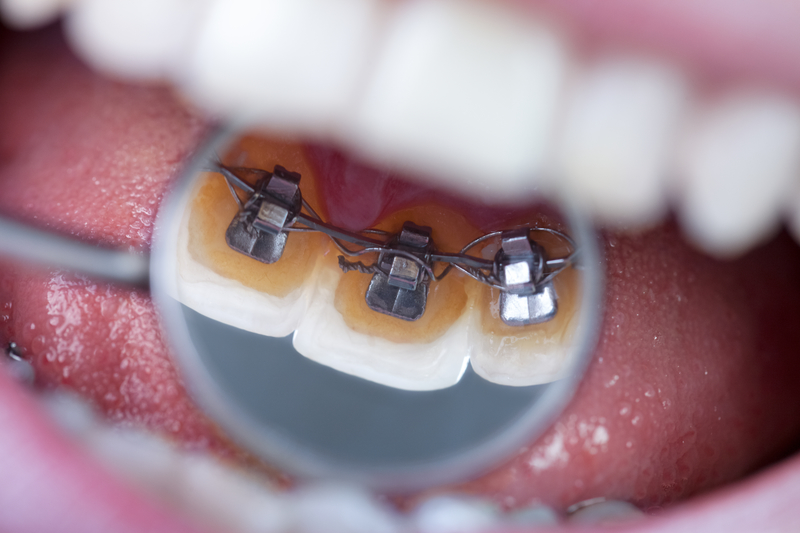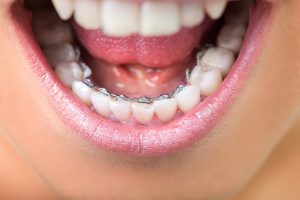What Advantages Do Lingual Braces Have Over Traditional?
Detect and Treat Cavities with Laser Dentistry
June 28, 2018Fluoride: How Important Is It?
July 11, 2018
Lingual braces are braces that go behind your teeth and can straighten your pearly whites in secret. Thinking about leveraging the power of lingual braces to straighten your smile? Consider the benefits that lingual braces can offer you:
- Correction of long-term or lifetime dental issues
- Less noticeable orthodontic treatment
- Good orthodontic treatment for athletes and for musicians who play wind instruments
- Increased confidence during treatment compared to traditional methods
- Elevated self-esteem after treatment
Lingual Braces 101
Many people are new to the idea of lingual braces and think that they are a fairly new orthodontic option. However, they were actually created in 1976,. In the past, many people didn’t care how they straightened their teeth. Now, however, it can be better for many professionals, teens and adults to straighten their teeth more discreetly. In modern times, people want better ways to straighten crooked teeth, which is why lingual braces were invented.
These are braces that are attached to the back of the teeth instead of the front. The process is similar to traditional metal braces, except that molds of the backs of the teeth must be made for a patient. Using those impressions, our lab can custom-make brackets and wires that fit the shape of your mouth. You have your first consultation where you have your impressions taken and then the lingual braces are placed during your second appointment. Instead of just a bracket on the tooth, the metal part will cover most of the back of your tooth with a metal bracket on the center. This holds the braces in place and makes them sturdy enough to move your teeth.

Dental Issues Fixed In Secret
There are various dental options to straighten crooked teeth. Invisalign treatment can effectively straighten. However, they can’t generally correct bite and alignment issues that are so prevalent in teens and even adults. If you want a hidden orthodontic apparatus, but you need dental issues corrected, lingual braces are your best option. Not all children are candidates for lingual braces, as the teeth have to be large enough behind to fit the braces. However, if a teen or child is able to have them, they are an amazing way to both fix dental issues (overbite, underbite, etc.) and to do it in secret. This is why lingual braces are sometimes referred to as “incognito braces”.
Playing Instruments and Lifestyle Benefits
Did you know that lingual braces work better for your mouth if you play instruments? Even though lingual braces are only a few millimeters away from where traditional metal braces would be in your mouth, location is key depending on your daily activities. Traditional braces can sometimes mess with the sound of wind instruments and can be hard to adjust to for music players. Part of this is because players have to purse their lips around an instrument, but there are brackets and wires there now. However, because lingual braces go behind the teeth, you can purse your lips and play instruments with ease.
Teens also don’t have to worry about dental emergencies and injuries to the mouth if they play sports. Traditional braces have brackets and wires on the front of the teeth that can cut the gums and cheeks in sports if a player is hit. It’s hard to break lingual brackets and wires because of their location, meaning players don’t have to worry about mouth injuries with their appliance.
Confidence Is Key
People who feel more confident will act more confident, and studies show that they will smile more. The Dental Tribune reported on a study conducted by Align Technology, which is the maker of Invisalign. They found that happiness and confidence directly related to a person’s smile. For most Americans, a person’s smile is one of the first things others notice. When people don’t have a straight smile or are self-conscious about their smiles, they smile less.
However, when patients straightened their teeth—especially in a manner that was “hidden” or inconspicuous—their confidence, happiness, health and more soared. When people on the street were interviewed about their opinion of their peer’s appearances, the study found the following:
- People with straight smiles were seen as 58% more likely to be successful.
- 45% more likely to get a job.
- 57% more likely to get a date.
- 47% were perceived as being healthy.
- People were seen as 21% more happy and 73% smarter.
- Almost every person with straighter teeth were seen as more confident.

Better Self-Esteem Through Orthodontics
Often, adults and teens want to avoid orthodontic treatment because they believe metal braces are unattractive, distracting or make them look childish. However, lingual braces can achieve the same effects as traditional metal braces without anyone ever knowing. Not only can a person feel better about their smile when they have lingual braces, but they can show it off continually as their teeth become straighter and straighter.
Studies show that people who straighten their smiles not only have more confidence, but they also boost their self-esteem as well. When you feel good about how you look, you act like it. Even though aesthetics and how you look shouldn’t matter in this world, the reality is that it does. In the past, you had to sacrifice how your smile looked for many months until it was straight. Now, you can straighten your teeth, feel confident and still achieve a beautiful smile through orthodontic treatment. Thinking about leveraging the power of lingual braces to straighten your smile? Call Hardy Pediatric Dentistry and Orthodontics today at (720) 887-6003 to get started on your straightening plan!